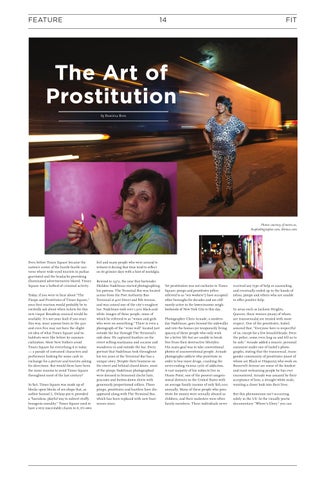FEATURE
14
FIT
The Art of Prostitution by Daniela Rios
Photos courtesy of metro.us, thephoblographer.com, ibtimes.com
Even before Times Square became the nation’s center of the hustle-bustle universe where wide-eyed tourists in parkas gravitated and the headache-provoking illuminated advertisements blared, Times Square was a hotbed of criminal activity. Today, if you were to hear about “The Pimps and Prostitutes of Times Square,” your first reaction would probably be to excitedly ask about when tickets for this new risqué Broadway musical would be available. It’s not your fault if you react this way, since anyone born in the 90s and even 80s may not have the slightest idea of what Times Square and its habitués were like before its commercialization. Most New Yorkers avoid Times Square for everything it is today — a parade of costumed characters and performers looking for some cash in exchange for a picture and tourists asking for directions. But would these have been the same reasons to avoid Times Square throughout most of the last century? In fact, Times Square was made up of blocks upon blocks of sex shops that, as author Samuel L. Delany put it, provided a “harmless, playful way to subvert stuffy bourgeois morality.” Times Square used to have a very inscrutable charm to it, it’s own
feel and many people who were around to witness it during that time tend to reflect on its grimier days with a hint of nostalgia. Rewind to 1972, the year that bartender Sheldon Nadelman started photographing his patrons. The Terminal Bar was located across from the Port Authority Bus Terminal at 41st Street and 8th Avenue, and was coined one of the city’s roughest bar. Nadelman took over 1,500 black-andwhite images of these people, some of which he referred to as “winos and girls who were on something.” There is even a photograph of the “wino wall” located just outside the bar through The Terminal’s side door. He captured hustlers on the street selling marijuana and cocaine and wanderers in and outside the bar. Every portrait that Nadelman took throughout his ten years at the Terminal Bar has a unique story. Despite their business on the street and behind closed doors, most of the pimps Nadelman photographed were dressed in brimmed cloche hats, peacoats and button-down shirts with generously proportioned collars. These pimps, prostitutes and hustlers have disappeared along with The Terminal Bar, which has been replaced with new businesses since.
Yet prostitution was not exclusive to Times Square: pimps and prostitutes (often referred to as “sex workers”) have occupied other boroughs for decades and are still mostly active in the lower-income neighborhoods of New York City to this day. Photographer Chris Arnade, a modern day Nadelman, goes beyond the sidewalks and into the homes (or temporarily living spaces) of these people who only wish for a better life but are unable to break free from their destructive lifestyles. His main goal was to take conventional photos of unconventional people. Arnade photographs addicts who prostitute in order to buy more drugs, cranking the never-ending vicious cycle of addiction. A vast majority of his subjects live in Hunts Point, one of the poorest congressional districts in the United States with an average family income of only $16,000 annually. Many of these people who prostitute for money were sexually abused as children, and their molesters were often family members. These individuals never
received any type of help or counseling, and eventually ended up in the hands of johns, pimps and others who are unable to offer positive help. In areas such as Jackson Heights, Queens, these women (many of whom are transsexuals) are treated with more respect. One of the prostitutes, Isabel, assured that, “Everyone here is respectful of us, except for a few knuckleheads. Even the police, some even hug us and tell us to be safe.” Arnade added a sincere, personal comment under one of Isabel’s photographs, stating that the transsexual, transgender community of prostitutes (most of whom are Black or Hispanic) who work on Roosevelt Avenue are some of the kindest and most welcoming people he has ever encountered. Arnade was amazed by their acceptance of him, a straight white male, wanting a closer look into their lives. But this phenomenon isn’t occurring solely in the US: In the visually poetic documentary “Whore’s Glory,” you can
